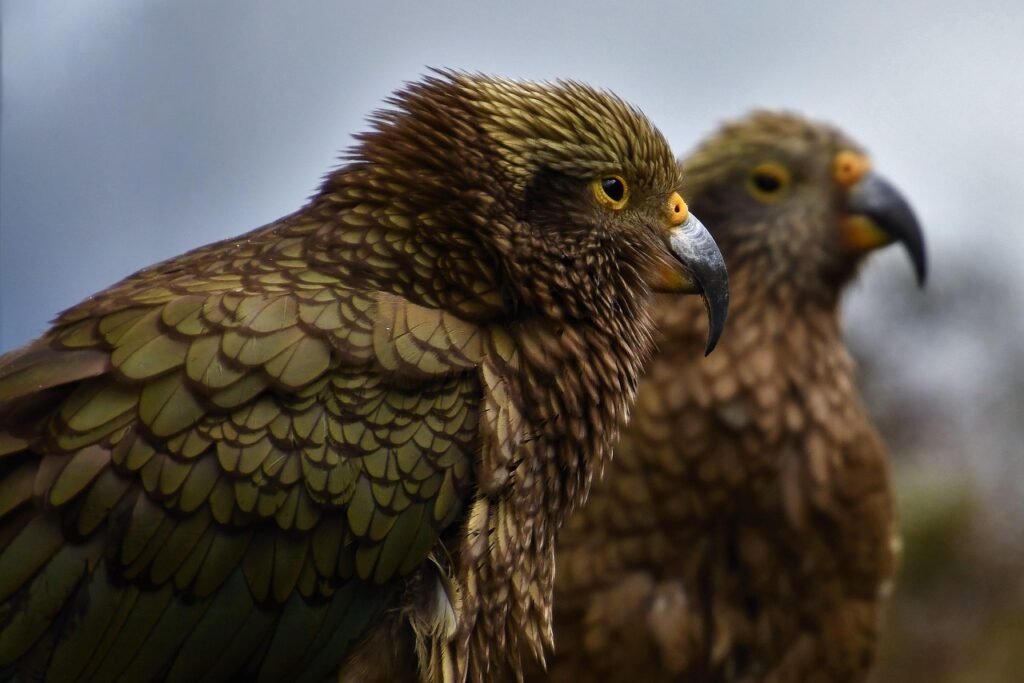New Zealand

Kakapo
New Zealand is a wild whisper, not a roar. Its creatures are quiet, often nocturnal, and tend to avoid the spotlight. Here, the drama isn’t in predators or speed. It’s in absence. No native land mammals. No snakes. Few natural threats. In this isolation, evolution drifted sideways. Birds forgot how to fly. Insects grew giant. Life slowed down and burrowed deep — until humans arrived, and everything changed.
Today, the wildlife of Aotearoa is both haunting and hopeful. Some species teeter at the edge. Others are coming back — one nest, one sanctuary, one protected island at a time. And behind it all is a culture that doesn’t just name the land — it reveres it. Māori tradition treats animals not as separate, but as relatives, woven into the spirit of place. In New Zealand, the wild is not scenery. It’s sacred.
A World Built on Stillness and Surprise
Strange Creatures, Ancient Rules
The Silence Speaks Volumes
New Zealand’s wild is subtle. You won’t find big cats or bears. What you’ll find is space. Air. Shadows moving at night. A sudden birdcall across empty water. Tracks in the sand where no human has walked. The land remembers what once was — and so do the animals, the trees, the caretakers restoring it species by species.
Not Just Conservation — Restoration
This is a country rewriting its relationship with the wild. Not by keeping people out, but by inviting them in — to learn, to listen, to protect. From replanting native bush to controlling invasive mammals to guarding every kiwi egg like a national treasure, the effort here isn’t passive. It’s a daily act of love.
Final Thoughts
New Zealand’s wildlife may not be loud, but it’s unforgettable. It moves in the dark, breathes beneath the leaves, and sings on the wind between islands. You won’t see everything here — and that’s the point. You’re not chasing drama. You’re stepping into a quieter wild — one that asks for stillness, patience, and respect. And if you offer those things, it will show you a kind of magic the rest of the world has almost forgotten.
Today, the wildlife of Aotearoa is both haunting and hopeful. Some species teeter at the edge. Others are coming back — one nest, one sanctuary, one protected island at a time. And behind it all is a culture that doesn’t just name the land — it reveres it. Māori tradition treats animals not as separate, but as relatives, woven into the spirit of place. In New Zealand, the wild is not scenery. It’s sacred.
A World Built on Stillness and Surprise
- Stewart Island (Rakiura): A last stronghold for night birds. Kiwis rustle in the undergrowth here, wild and unbothered by people.
- Offshore Sanctuaries: Places like Tiritiri Matangi, Kapiti, and Zealandia fence out invasive predators — and allow species like the kākāpō, tīeke (saddleback), and tuatara to recover.
- Fiordland: Waterfalls cascade through cliffs cloaked in beech forest. Rare yellow-eyed penguins nest on hidden beaches, and kea — alpine parrots with curious eyes — tear apart anything left unattended.
- Northland & Kauri Forests: Home to giant trees and older rhythms. Glowworms, long-tailed bats, and native geckos live in places where the silence is thick and ancient.
- Coastal Waters: Humpbacks, orcas, dusky dolphins — plus seabirds like the albatross, shearwater, and petrel, riding the wild wind offshore.
Strange Creatures, Ancient Rules
- Kākāpō: Flightless, moss-colored, nocturnal parrot. Nearly extinct, now monitored like royalty on offshore islands.
- Kea: The world’s only alpine parrot — clever, bold, destructive, and hilarious.
- Tuatara: A reptile older than dinosaurs — not a lizard, not quite anything else. Found only here.
- Kiwi: Shy, nocturnal, and deeply symbolic. Seen rarely. Felt everywhere.
- Giant Wētā: Prehistoric insects the size of a mouse. Harmless, slow, and built for a world without predators — a world that’s mostly gone.
The Silence Speaks Volumes
New Zealand’s wild is subtle. You won’t find big cats or bears. What you’ll find is space. Air. Shadows moving at night. A sudden birdcall across empty water. Tracks in the sand where no human has walked. The land remembers what once was — and so do the animals, the trees, the caretakers restoring it species by species.
Not Just Conservation — Restoration
This is a country rewriting its relationship with the wild. Not by keeping people out, but by inviting them in — to learn, to listen, to protect. From replanting native bush to controlling invasive mammals to guarding every kiwi egg like a national treasure, the effort here isn’t passive. It’s a daily act of love.
Final Thoughts
New Zealand’s wildlife may not be loud, but it’s unforgettable. It moves in the dark, breathes beneath the leaves, and sings on the wind between islands. You won’t see everything here — and that’s the point. You’re not chasing drama. You’re stepping into a quieter wild — one that asks for stillness, patience, and respect. And if you offer those things, it will show you a kind of magic the rest of the world has almost forgotten.
